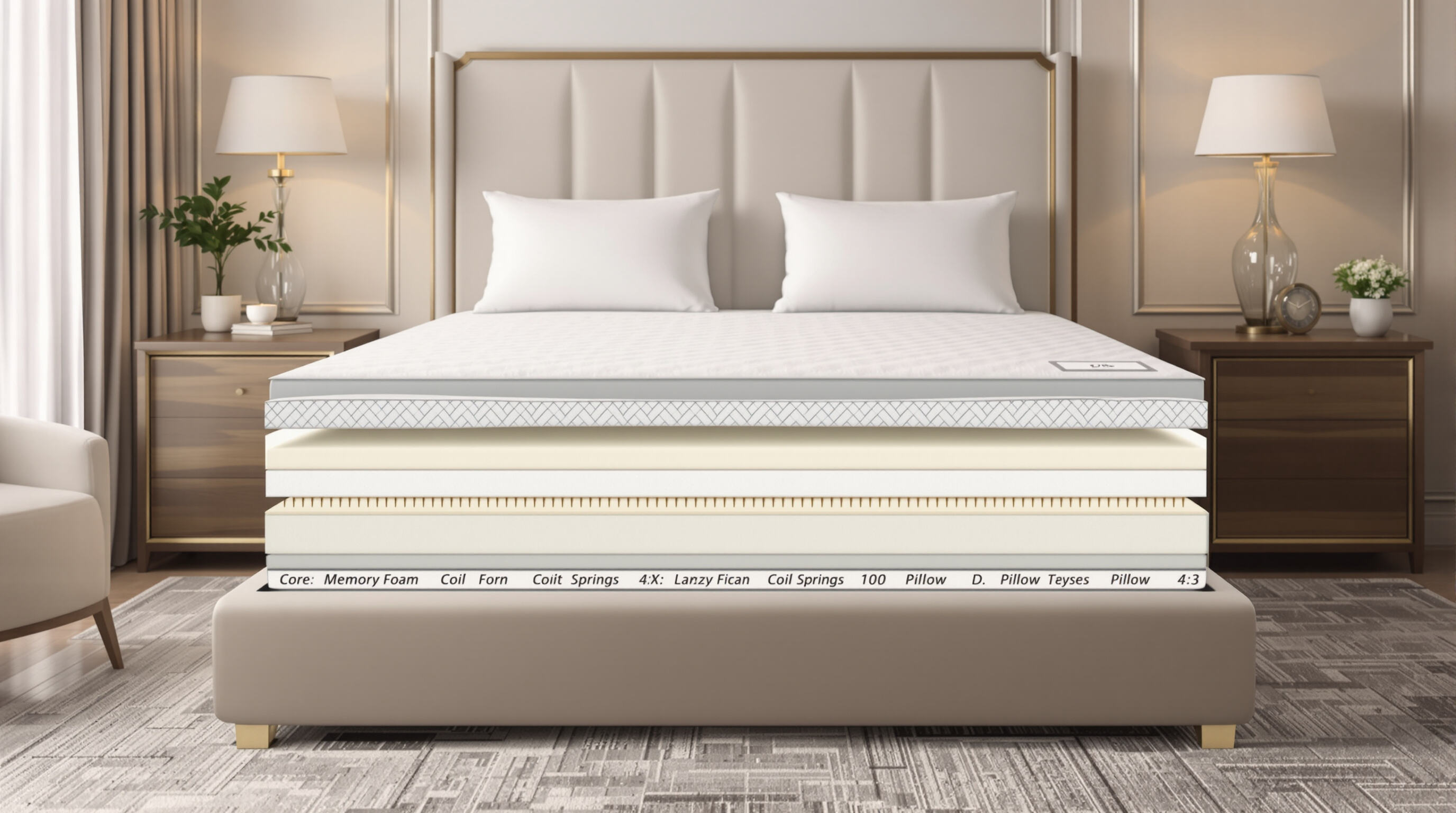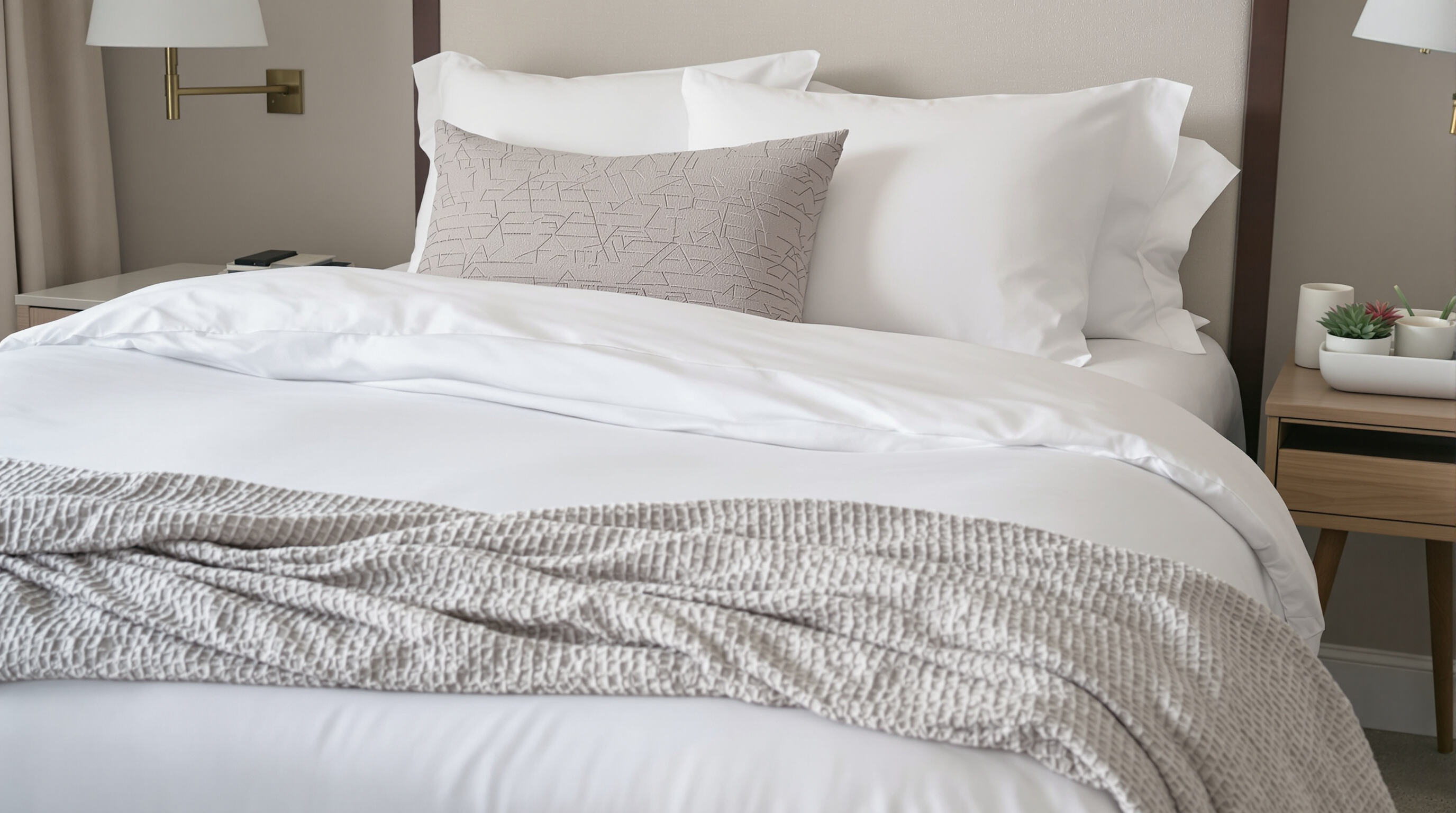These days, folks traveling around want the same kind of restful nights they get at hotels right in their own beds. A recent study showed something interesting: almost three quarters of travelers put bed comfort right at the top when it comes to how satisfied they are with accommodations. Hotels know this well and go all out on bedding setups. Think about those fancy mattress combinations where they layer a hybrid base with soft featherbeds on top, plus they really care about the fabrics used. The big name luxury brands? They typically opt for what's called triple sheeting - that means a fitted sheet, then a flat one, and finally a nice thick duvet cover. This setup manages to keep things breathable while still feeling super comfortable, giving guests that perfect mix of freshness and coziness that makes them want to stay in bed longer than planned.
When it comes to hotel sleeping arrangements, most premium accommodations invest heavily in mattress technology. Think about those fancy beds with multiple layers working together – there's usually a dense foam foundation beneath everything else, then those individual coil springs that supposedly stop movement from traveling across the bed, plus soft tops that mold around the body. Take The Westin's famous Heavenly Bed as just one instance. It has this impressive 13 inch spring system underneath what they call a Euro top layer designed specifically to take pressure off sensitive areas. According to some studies, guests report waking up fewer times during the night when staying on these specialized mattresses, maybe even cutting disturbances down by something like 30 percent over regular home beds. Makes sense why travelers keep coming back for another good night's rest after all.
More and more travelers are starting to notice the difference when hotels use long staple Egyptian cotton sheets with thread counts over 600 along with sateen weave fabrics. These materials feel super smooth against the skin and actually help keep people cool during the night. Luxury hotels have been jumping on the bandwagon with OEKO TEX certified bedding too. These certifications basically mean the fabric hasn't been treated with any nasty chemicals that could irritate sensitive skin, plus they tend to last longer between replacements. According to research out of Cornell University last year, around two thirds of hotel guests now link those green certifications directly to getting better rest at night.
Working alongside a bedding company that focuses on hotel quality materials can really help bring about this kind of luxurious feel at home. Begin by getting a mattress topper infused with cooling gel placed on top of a medium firm hybrid mattress. Then throw in some nice sateen sheets and pair them with a down alternative comforter for that extra touch of comfort. Want to take things even further? Consider implementing something similar to what hotels do with their pillow menus. Guests love being able to pick between different types of pillows, so why not offer options such as firm memory foam or those special hypoallergenic ones too? This small addition makes all the difference when trying to create that authentic hotel bedroom atmosphere right in one's own space.

Hotel style comfort really comes down to getting the right combination of things working together. A good support base from the mattress paired with soft pillows and something that regulates body temperature makes all the difference. Most upscale hotels go for medium firm memory foam or hybrid beds according to those folks over at Upgraded Points research, which shows around 8 out of 10 high end places stick with this type of mattress because they offer decent pressure relief while keeping spines aligned properly. For bedding accessories, synthetic down pillows work well alongside breathable covers filled with materials sourced responsibly. Don't forget to switch out these items every three months or so. Regular rotation helps them last longer and keeps everything cleaner overall.
Mattresses that don't quite hit the luxury level of hotel beds often benefit from adding a 2 to 3 inch thick topper. These extra layers really make a difference in overall comfort. Research from last year on how long bedding lasts suggests that high density latex or those fancy gel infused foam options can actually prolong mattress lifespan around 40 percent while cutting down on movement disturbance between partners by about two thirds. When shopping around, look for ones featuring cooling fabric covers and built in antimicrobial protection. These features not only keep things feeling fresh but also create a safer sleeping environment, which matters a lot for people who tend to sleep hot or suffer from allergies.
When looking for quality bedding solutions, it's worth going with manufacturers who have certifications from OEKO-TEX® for chemical safety standards and RDS for responsible down sourcing practices. Recent research into what hotels require found something interesting about their mattress specs compared to what's sold in stores. Hotel grade models tend to pack about 15 percent denser foam materials and include roughly 30% more coil systems, which makes those edges stronger and generally lasts much longer over time. For anyone serious about comfort, finding suppliers that allow adjustments in firmness levels becomes really important. Also check if they offer solid guarantees, ideally around ten years coverage for essential parts such as coil systems or natural latex layers.
Looking for good guest bedding? Cotton weaves such as percale and sateen are worth considering. Percale has that classic one over one weave pattern which gives it a nice crisp feel while still letting air circulate pretty well. Most folks find thread counts between 300 to 400 work best according to Forbes from last year. Then there's sateen with its three over one weave that creates this smooth, shiny look people love so much. The downside? It tends to hold onto warmth a bit more than other options. Linen is another great choice for those hot summer nights when breathing room matters most. It brings in that earthy texture everyone admires these days, although let's face it, those casual wrinkles might clash with some interior styles out there.
Many luxury hotels blend materialsâsuch as linen-cotton hybridsâfor year-round comfort. A 2024 study found that 68% of high-end properties use percale or sateen sheets with thread counts between 300â600, balancing softness and airflow.
Fabrics made from bamboo such as viscose and lyocell feel really smooth against skin and help regulate body temperature naturally. According to tests run by The Spruce, these materials dissipate heat about 40 percent faster compared to regular cotton fabric. On the flip side though, cotton tends to keep colors looking bright for much longer time. After around fifty washes, cotton still retains about 25% more color intensity than many other fabrics, according to research published by Piret in 2023. People who suffer from allergies might want to look for OEKO TEX certified materials since they cut down on skin irritation risks by roughly three quarters. When choosing textiles, combining natural fibers with special weaving techniques that manage temperature can create something similar to what guests experience in top rated hotels.

Start with good quality sheets that feel nice against the skin, around 400 to 600 threads works well for most people. Layer on top with something warm but not too heavy like a regular duvet or quilt. Throw in a light blanket as well so folks can adjust how cozy they want to get. Pillow arrangement matters too â maybe go with two regular ones plus one bigger Euro style pillow, along with a small lumbar cushion to add some interest visually. The whole setup should feel soft when touched and look interesting from across the room. Think about combinations that work together nicely, such as a simple linen coverlet paired with a thick knitted blanket, which gives off those boutique hotel vibes without breaking the bank.
A 2024 study found that 78% of guests adjust bedding layers during their stay. To support this, implement a dual-layer system:
This approach allows guests to personalize warmth without compromising aesthetic polish. Partnering with a bedding manufacturer experienced in commercial-grade linens ensures layers retain structure and softness through repeated launderingâa key priority in hospitality settings.
The insulation properties of down comforters come from their natural loft, which is rated based on something called fill power ranging from around 600 up to over 900. Basically, the higher the fill power number, the better the comforter will keep someone warm while being lighter in weight, making it particularly good for folks living in colder regions. For those who might have allergies or prefer synthetic materials, there are alternatives available now such as Tencel fabric or recycled polyester blends that mimic the same kind of loft characteristics but won't trigger allergic reactions. According to research published last year, nearly two thirds of hotels across the country have started using these down substitute mixtures specifically so they can cater to guests with sensitivities issues during their stay.
Goose down typically offers higher fill power (750â850) than duck down (500â700), with 20% better heat retention in third-party testing. Baffle-box stitching prevents clumping and ensures even distribution. Luxury bedding manufacturers often use European white goose down with RDS certification to guarantee ethical sourcing.
These certifications reduce allergy risks by 42% compared to non-certified bedding (Ponemon 2022).
Budget-friendly down-alternatives (<$150) now match mid-range down comforters in thermal performance, according to 2024 Consumer Reports. For premium stays, consider European goose down comforters with 800+ fill power and sateen covers for temperature regulation. Recent durability tests show high-end options retain 90% of their loft after five years with proper care.
Hotel beds typically feature advanced mattress technology and multiple layers for optimal comfort. They often have a combination of dense foam foundations, coil springs to reduce movement, and soft tops that contour to the body.
To replicate the hotel sleep experience at home, invest in a high-quality mattress topper, luxury sheets, and a down alternative comforter. Consider offering a variety of pillow options to accommodate different preferences.
Look for certifications such as OEKO-TEX for chemical safety and Responsible Down Standard (RDS) for ethical down sourcing. These certifications ensure safer and more sustainable bedding products.
Percale and sateen cotton weaves are popular for their breathability and softness. Linen is also a great option for hot climates due to its high breathability.
 Hot News
Hot News2025-09-04
2025-09-02
2025-09-01
2025-07-08
2025-06-10
2025-11-27